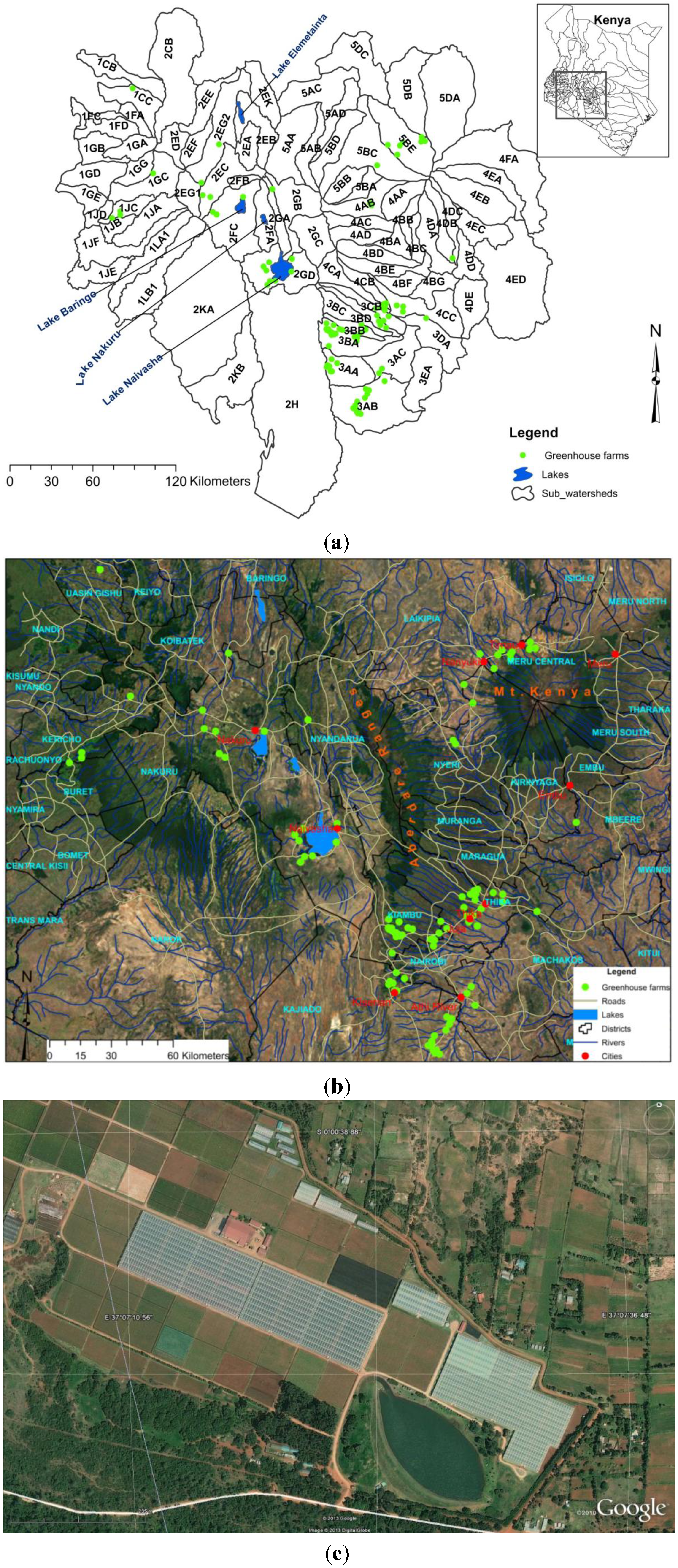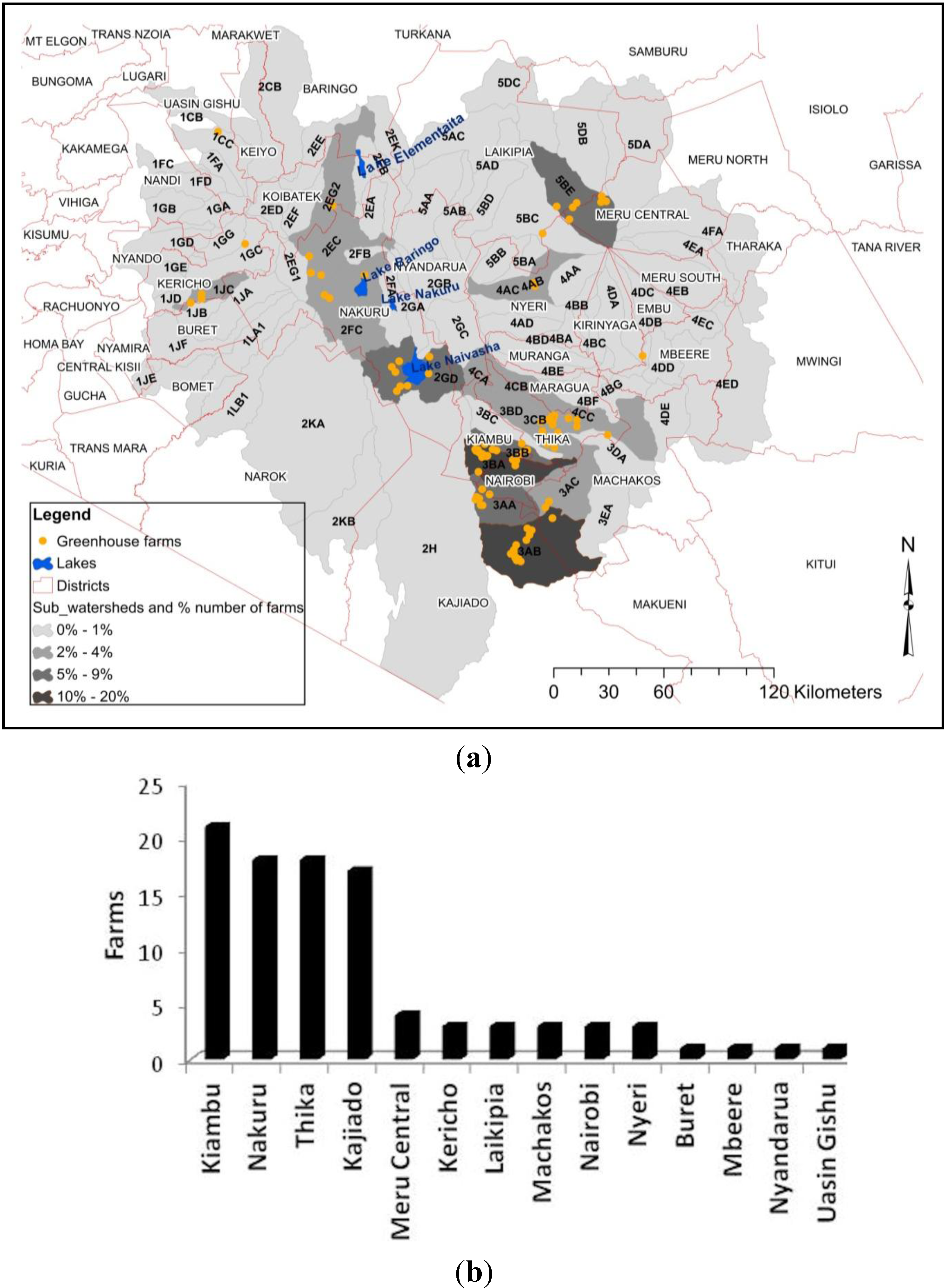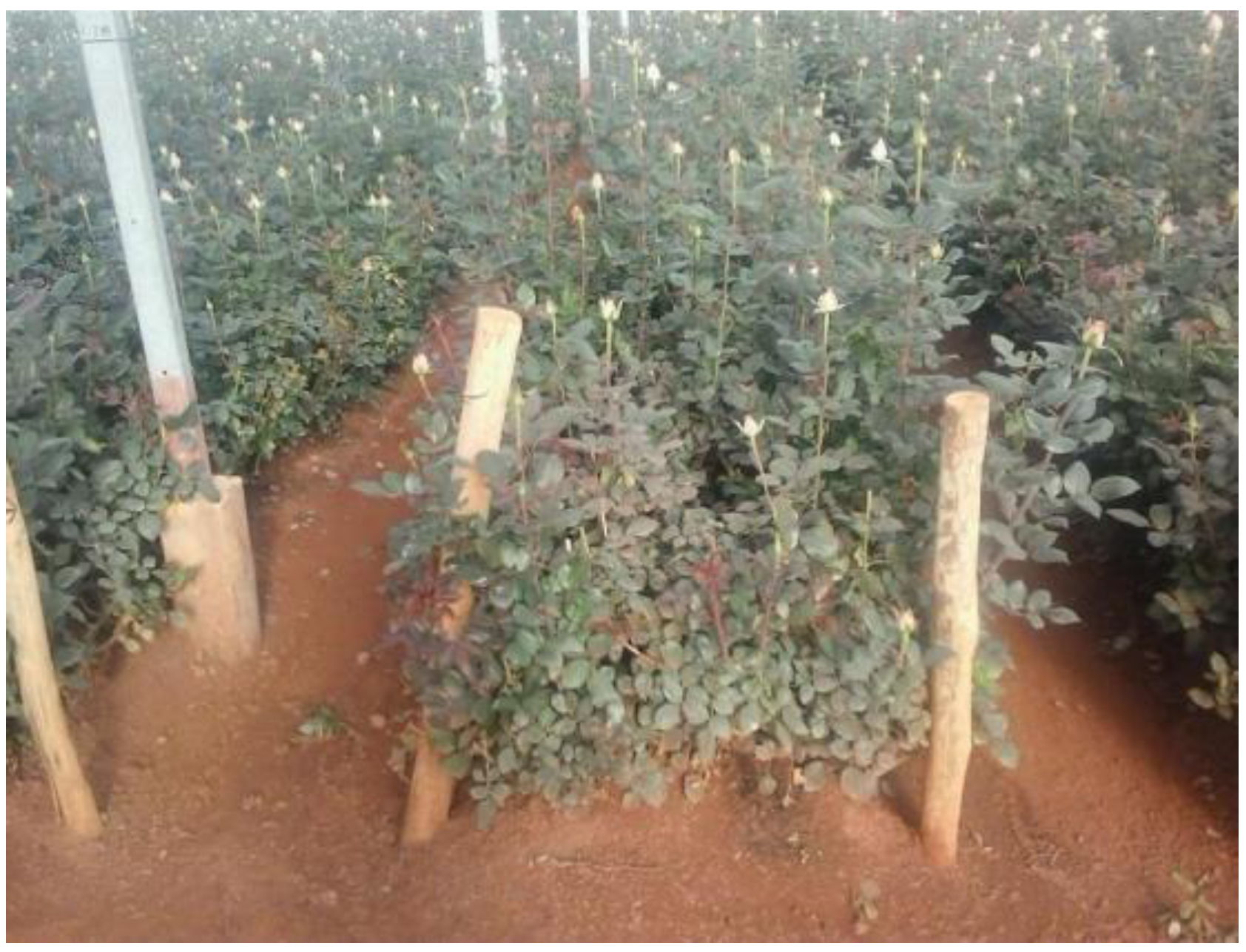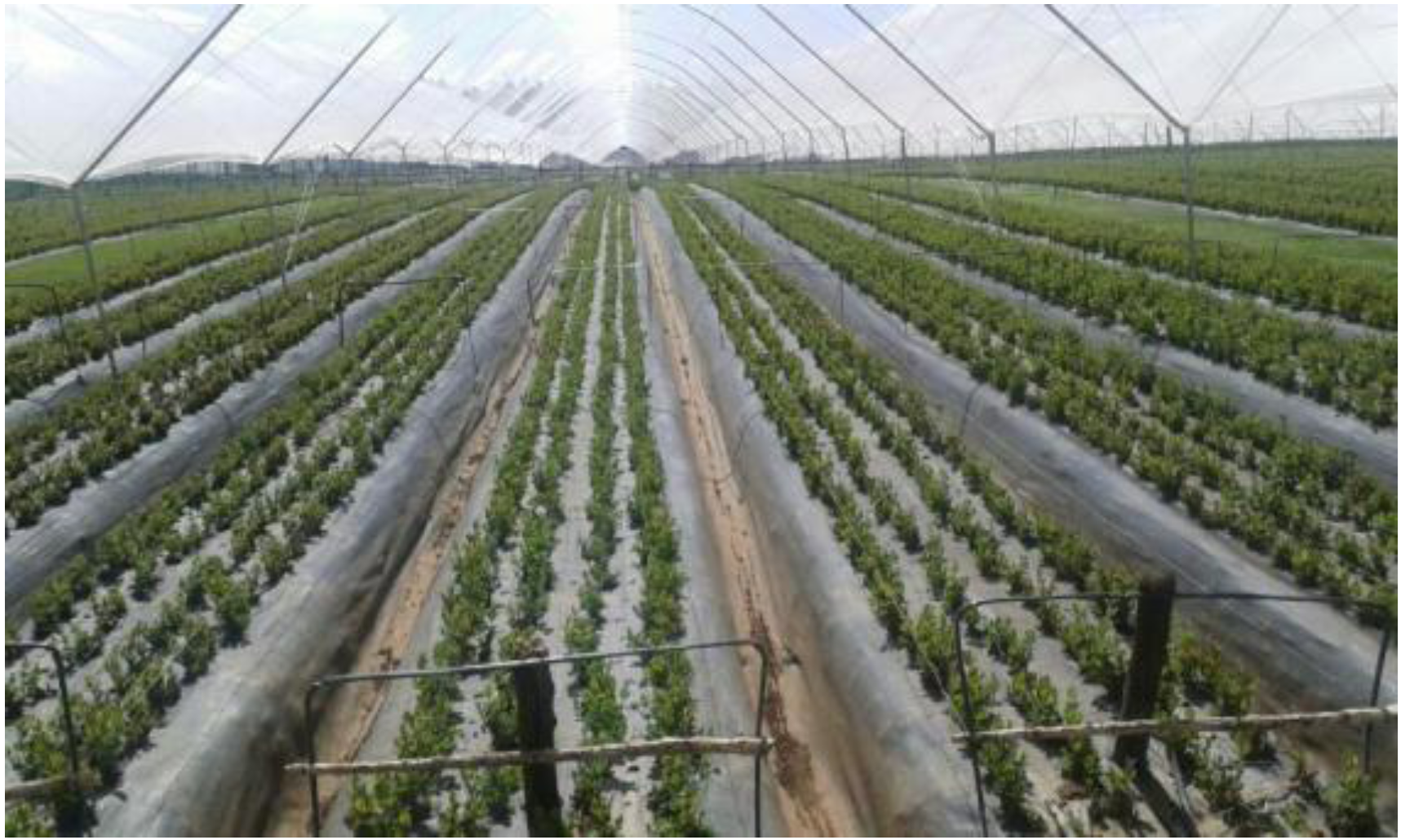Spatial Distribution of Greenhouse Commercial Horticulture in Kenya and the Role of Demographic, Infrastructure and Topo-Edaphic Factors
Abstract
:1. Introduction
2. Materials and Methods
2.1. Study Area

2.2. Data Acquisition and Processing
3. Results
3.1. Spatial Distribution and Area under Greenhouse Commercial Horticulture

| Area under Greenhouses (sq. km) | No. of Farms 2000–2003 | No. of Farms 2010–2011 |
|---|---|---|
| 0 | 30 ** | 4 * |
| 0.01–0.02 | 10 | 16 |
| 0.02–0.04 | 13 | 21 |
| 0.04–0.06 | 14 | 11 |
| 0.06–0.08 | 13 | 10 |
| 0.08–0.10 | 9 | 14 |
| 0.10–0.12 | 2 | 9 |
| 0.12–0.14 | 2 | 5 |
| 0.14–0.16 | 2 | 3 |
| 0.16–0.18 | 0 | 3 |
| 0.18–0.20 | 0 | 2 |
| 0.20–0.22 | 1 | 2 |
| >0.4 | 0 | 1 |
| Total Farms | 66 | 97 |
3.2. Significance of Topo-Edaphic, Demographic and Infrastructure Factors in Predicting Farm Locations
| Model Summary | Anova | Unstandardized Coefficients | |||||||
|---|---|---|---|---|---|---|---|---|---|
| Model | Adjusted R-Square | df | F | sig. | Model | B | t | Sig. | |
| (Constant) | 0.127 | 2.826 | 0.006 | ||||||
| 1 | 0.84 | 83 | 449.82 | 0.00 | 1 | Dams | 0.642 | 21.209 | 0.000 |
| 2 | 0.86 | 83 | 449.82 | 0.00 | 2 | (Constant) | 0.013 | 0.249 | 0.804 |
| Dams | 0.613 | 20.899 | 0.000 | ||||||
| POPden09 | 0.001 | 3.664 | 0.000 | ||||||
| 3 | 0.88 | 83 | 194.9 | 0.00 | 3 | (Constant) | 0.37 | 2.711 | 0.008 |
| Dams | 0.598 | 20.862 | 0.000 | ||||||
| POPden09 | 0.001 | 4.537 | 0.000 | ||||||
| AvgRainfall | 0.00 | −2.813 | 0.006 | ||||||
| 4 | 0.88 | 83 | 154.69 | 0.00 | 4 | (Constant) | 0.535 | 3.513 | 0.001 |
| Dams | 0.595 | 21.254 | 0.000 | ||||||
| POPden09 | 0.001 | 4.112 | 0.000 | ||||||
| AvgRainfall | 0.00 | −2.713 | 0.008 | ||||||
| AvgSlope | −0.059 | −2.232 | 0.028 | ||||||
4. Discussion
4.1. Spatial Distribution of Greenhouse Commercial Horticulture
4.2. Changes in Area under Greenhouse Cultivation
4.3. Role of Different Factors in Determining Spatial Location of Greenhouse Farms
4.3.1. Significant Predictors
4.3.2. Non Significant Factors: Soil Characteristics, River Density, Road Density and Depth of Bedrock
4.3.3. Suitability of Google Earth and Downloaded Data
5. Conclusion
Acknowledgments
Author Contributions
Conflicts of Interest
References
- Dolan, C.; Humphrey, J. Changing governance patterns in the trade in fresh vegetables between Africa and the United Kingdom. Environ. Plan. 2004, 36, 491–509. [Google Scholar] [CrossRef]
- Dever, J. Case Study #6-5. Small-Farm Access to High-Value Horticultural Markets in Kenya. In Food Policy for Developing Countries: Case Studies; Andersen, P.P., Cheng, F., Eds.; Cornell University Library: Ithaca, NY, USA, 2007; p. 12. [Google Scholar]
- Gemech, F.; Struthers, J. Coffee price volatility in Ethiopia: Effects of market reform programmes. J. Int. Dev. 2007, 19, 1131–1142. [Google Scholar] [CrossRef]
- Ponte, S. Behind the coffee crisis. Econ. Polit. Wkly. 2001, 24, 4410–4417. [Google Scholar]
- Mehta, A.; Chavas, J.P. Responding to the coffee crisis: What can we learn from price dynamics? J. Dev. Econ. 2008, 85, 282–311. [Google Scholar] [CrossRef]
- Ministry of Agriculture Government of Kenya. National Horticultural Policy. Available online: http://www.kilimo.go.ke (accessed on 14 May 2013).
- Regmi, A. Changing Structure of Global Food Consumption and Trade; Agriculture and Trade Report WRS-01-1; U.S. Department of Agriculture: Washington, DC, USA, 2001. [Google Scholar]
- Van Vliet, N.; Reenberg, A.; Rasmussen, L.V. Scientific documentation of crop land change in the Sahel: A half empty box of knowledge to support policy? J. Arid Environ. 2013, 95, 1–13. [Google Scholar] [CrossRef]
- Weinberger, L. Diversification into horticulture and poverty reduction: A research agenda. World Dev. 2007, 35, 1464–1480. [Google Scholar] [CrossRef]
- Gehlar, M.; Regmi, A. Factors Shaping Global Food Markets. In New Directions in Global Food Markets; U.S. Department of Agriculture, Economic Research Service: Washington, DC, USA, 2005. [Google Scholar]
- Noluthando, N.; Eloff, J.N. The South African floricultural industry and the Plant Breeders’ Rights Act: A short review. World Patent Inf. 2012, 34, 224–228. [Google Scholar] [CrossRef]
- Toroka, E. Horticulture: Tanzania Invades Kenya’s Last Corner of Competitive Advantage. Available online: http://businesstimes.co.tz/ (accessed on 10 January 2013).
- Thoen, R.; Jaffee, S.; Dolan, C. Equatorial Rose: The Kenyan-European Cut Flower Supply Chain. In Supply Chain Development in Emerging Markets: Case Studies of Supportive Public Policy; Kopiki, R., Ed.; World Bank: Washington, DC, USA, 2000. [Google Scholar]
- Weatherspoon, D.D.; Reardon, T. The rise of supermarkets in Africa: implications for agrifood systems and the rural poor. Dev. Policy Rev. 2003, 21, 333–355. [Google Scholar] [CrossRef]
- Dolan, C.S. Gender and witchcraft in agrarian transition: The case of Kenyan horticulture. Dev. Chang. 2002, 33, 659–681. [Google Scholar]
- Dehnen-Schmutz, K.; Holdenrieder, O.; Jeger, M.J.; Pautasso, M. Structural change in the international horticultural industry: Some implications for plant health. Sci. Hortic. 2010, 125, 1–15. [Google Scholar] [CrossRef]
- Kenya Flower Council. Flower Growing Areas in Kenya. Available online: http://www.kenyaflowercouncil.org/ (accessed on 10 May 2013).
- Aeschbacher, J.; Liniger, H.P.; Weingartner, R. River water shortage in a highland-lowland system: A case study of the impacts of water abstraction in the Mount Kenya region. Mount. Res. Dev. 2005, 25, 155–162. [Google Scholar] [CrossRef]
- Ulrich, A.; Speranza, C.I.; Roden, P.; Kiteme, B.; Wiesmann, U.; Nüsser, M. Small-scale farming in semi-arid areas: Livelihood dynamics between 1997 and 2010 in Laikipia, Kenya. J. Rur. Stud. 2012, 28, 241–251. [Google Scholar] [CrossRef]
- Sieverding, E. Ecology of VAM fungi in tropical agrosystems. Agric. Ecosyst. Environ. 1990, 29, 369–390. [Google Scholar] [CrossRef]
- Oehl, F.; Sieverding, E.; Ineichen, K.; Mäder, P.; Boller, T.; Wiemken, A. Impact of land use intensity on the species diversity of arbuscular mycorrhizal fungi in agroecosystems of central Europe. Appl. Environ. Microbiol. 2003, 69, 2816–2824. [Google Scholar] [CrossRef]
- Mohammad, M.J.; Hamad, S.R.; Malkawi, H.I. Population of arbuscular mycorrhizal fungi in semi-arid environment of Jordan as influenced by biotic and abiotic factors. J. Arid Environ. 2003, 53, 409–417. [Google Scholar] [CrossRef]
- Owiti, G.E.; Oswe, I.A. Human impact on lake ecosystems: The case of Lake Naivasha, Kenya. Afr. J. Aquatic Sci. 2007, 32, 79–88. [Google Scholar] [CrossRef]
- Clevo, W. Environmental and human costs of commercial agricultural production in South Asia. Int. J. Soc. Econ. 2000, 2, 816–846. [Google Scholar]
- Tegtmeier, E.M.; Duffy, M.D. External costs of agricultural production in the United States. Int. J. Agric. Sustain. 2004, 2, 1–19. [Google Scholar] [CrossRef]
- Kareri, R. Some Aspects of the Geography of Kenya. In Proceedings of the Indiana University-Perdue University Indianapolis (IUPUI) Fulbright Hays Group Projects Symposium, Eldoret, Kenya, 9 July–3 August 2010.
- Van de Steeg, J.A.; Verburg, P.H.; Baltenweck, I.; Staal, S.J. Characterization of the spatial distribution of farming systems in the Kenyan Highlands. Appl. Geogr. 2010, 30, 239–253. [Google Scholar] [CrossRef]
- Notter, B. Rainfall-Runoff Modeling of Meso-Scale Catchments in the Upper Ewaso Ng’iro Basin, Kenya. M.Sc. Thesis, University of Berne, Bern, Switzerland, 2003. [Google Scholar]
- Dougall, H.W.; Glover, P.E. On the chemical composition of Themeda triandra and Cynodon dactylon. Afr. J. Ecol. 1964, 2, 67–70. [Google Scholar] [CrossRef]
- Murage, E.W.; Karanja, N.K.; Smithson, P.C.; Wooner, P.L. Diagnostic indicators of soil quality in productive and non-productive smallholders’ fields of Kenya’s Central Highlands. Agric. Ecosyst. Environ. 2000, 79, 1–8. [Google Scholar] [CrossRef]
- World Resources Institute. Download Kenya GIS data. Available online: http://www.wri.org (accessed on 20 April 2012).
- Philip, C.E.; Richard, T.W.; Bihong, F.; Michael, A.F. A bound on the viscosity of the Tibetan crust from the horizontality of palaeolake shorelines. Earth Planet. Sci. Lett. 2013, 375, 44–56. [Google Scholar] [CrossRef]
- Farr, T.G.; Rosen, P.A.; Caro, E.; Crippen, R.; Duren, R.; Hensley, S.; Kobrick, M.; Paller, M.; Rodriguez, E.; Roth, L.; et al. The shuttle radar topography mission. Rev. Geophys. 2007, 45. [Google Scholar] [CrossRef]
- John, R.T.; Sarah, T.L. Mapping public and private spaces of urban agriculture in Chicago through the analysis of high-resolution aerial images in Google Earth. Lands. Urban Plan. 2012, 108, 57–70. [Google Scholar] [CrossRef]
- Karim, S.; Xavier, R. Google Earth, GIS and stone-walled structures in southern Gauteng, South Africa. J. Archaeol. Sci. 2012, 39, 1034–1042. [Google Scholar] [CrossRef]
- Yansen, W.; Giap, H.; Chatt, W. Integration of Google Maps/Earth with microscale meteorology models and data visualization. Comput. Geosci. 2013, 61, 23–31. [Google Scholar] [CrossRef]
- Rasband, W.S.; ImageJ, U.S. National Institutes of Health, Bethesda, Maryland, USA, 1997–2012. Available online: http://imagej.nih.gov/ij/ (accessed on 10 December 2013).
- Getting to Know Measuring in ImageJ. Available online: http://serc.carleton.edu/eyesinthesky2/week2/get_to_know_imagej.html#spatial_calibration (accessed on 11 November 2013).
- Ross, D.S. Greenhouse Systems—Selection and Placemen. In Total Crop Management for Greenhouse Production; University of Maryland: College Park, MD, USA, 2002; pp. 121–124. [Google Scholar]
- Ritzema, H.P.; Satyanarayana, T.V.; Raman, S.; Boonstra, J. Subsurface drainage to combat waterlogging and salinity in irrigated lands in India: Lessons learned in farmers’ fields. Agric. Water Manag. 2008, 95, 179–189. [Google Scholar] [CrossRef]
- Tavakkoli, E.; Rengasamy, P.; McDonald, G.K. High concentrations of Na+ and Cl− ions in soil solution have simultaneous detrimental effects on growth of faba bean under salinity stress. J. Exp. Bot. 2010, 61, 4449–4459. [Google Scholar] [CrossRef]
- Genhua, N.; Rodriguez, D.S.; Aguiniga, L. Effect of saline water irrigation on growth and physiological responses of three rose rootstocks. HortScience 2008, 43, 1479. [Google Scholar]
- International Livestock Research Institute GIS datasets. Available online: http://www.ilri.org/gis (accessed on 12 November 2012).
- Sombroek, W.G.; Braun, H.M.H.; van der Pouw, B.J.A. Exploratory Soil Map and Agro-Climatic Zone Map of Kenya (Scale 1:1,000,000); Kenya Soil Survey: Nairobi, Kenya, 1982. [Google Scholar]
- Titonell, P.; Muriuki, A.; Shepherd, K.D.; Mugendi, D.; Kaizzi, K.C.; Okeyo, J.; Verchot, L.; Coe, R.; Vanlauwe, B. The diversity of rural livelihoods and their influence on soil fertility in agricultural systems of East Africa—A typology of smallholder farms. Agric. Sys. 2010, 103, 83–97. [Google Scholar] [CrossRef]
- Natural Resources Conservation Service. Soil Sodium Testing. Available online: http://www.mt.nrcs.usda.gov/technical/ecs/plants/technotes/pmtechnoteMT60/sodium_test.html (accessed on 12 April 2013).
- Freer, J.; McDonnell, J.J.; Beven, K.J.; Peters, N.E.; Burns, D.A.; Hooper, R.P.; Aulenbach, B.; Kendall, C. The role of bedrock topography on subsurface storm flow. Water Resour. Res. 2002, 38. [Google Scholar] [CrossRef]
- Kazemi, M.L.; Dumenil, L.C.; Fenton, T.E. Department of Agronomy Iowa State University: Ames, IA, USA; Effects of Accelerated Erosion on Corn Yields of Loess Derived and Till-derived Soils in Iowa. Unpublished Technical Report. 1990. [Google Scholar]
- Kenya National Bureau of Statistics. National Population and Housing Census Results 2009: Population Distribution by Age, Sex, and Administrative Units, Nairobi, Kenya. Available online: https://opendata.go.ke (accessed on 25 October 2012).
- Osborne, J. Notes on the Use of Data Transformations, Practical Assessment, Research & Evaluation. Available online: http://PAREonline.net/getvn.asp?v=8&n=6 (accessed on 21 May 2013).
- Montgomery, D.C.; Peck, E.A.; Vining, G.G. Introduction to Linear Regression Analysis, 4th ed.; John Wiley & Sons, Inc: Hoboken, NJ, USA, 2006. [Google Scholar]
- English, P.; Jafee, S. Exporting out of Africa—Kenya’s Horticulture Success Story. In Proceedings of the Scaling up Poverty Reduction: A Global Learning Process and Conference, Shanghai, China, 25–27 May 2004.
- Hornberger, K.; Ndiritu, N.; Ponce-Brito, L.; Tashu, M.; Watt, T. Kenya’s Flower Cluster. Available online: http://www.isc.hbs.edu/pdf/Student_Projects/Kenya_Cut-FlowerCluster_2007.pdf (accessed on 10 February 2013).
- Veerle, V.; Dessein, J.; Lauwers, L. Transition towards Sustainability: Dutch Greenhouse Parks as a Touchstone for Flemish Clustering Experiments. In Proceedings of the 12th Congress of the European Association of Agricultural Economists, Ghent, Belgium, 26–29 August 2008.
- Altes, W.K.; Korthals, E.R. Planning the horticultural sector managing greenhouse sprawl in the Netherlands. Land Use Policy 2013, 31, 486–497. [Google Scholar] [CrossRef]
- Badgery-Parker, J. Greenhouse Horticulture—Beyond Australia. Available online: http://www.dpi.nsw.gov.au/__data/assets/pdf_file/0006/119409/greenhouse-horticulture-beyond-australia.pdf (accessed on 20 May 2013).
- Rogge, E.; Nevens, F.; Gulinck, H. Reducing the visual impact of “greenhouse parks” in rural landscapes. Lands. Urban Plan. 2008, 87, 76–83. [Google Scholar] [CrossRef]
- Ponte, S. Brewing a bitter cup? Deregulation, quality and the re-organization of coffee marketing in East Africa. J. Agrar. Chang. 2002, 2, 248–272. [Google Scholar]
- Carswell, G. Agricultural Intensification and Rural Sustainable Livelihoods: A Think Piece. Available online: http://www.ids.ac.uk/files/dmfile/Wp64.pdf (accessed on 2 April 2013).
- Horticultural Crops Development Authority (HCDA). Available online: http://www.hcda.or.ke (accessed on 12 January 2013).
- Fresh Produce Exporters Association of Kenya (FPEAK). Kenya’s Horticultural Industry at a Glance. Available online: http://www.fpeak.org/khc.html (accessed on 12 January 2013).
- Joly, F.J.C.; Samdanjigmed, T.; Cottereau, V.; Feh, C. Ecological constraints on and consequences of land use heterogeneity: A case study of the Mongolian Gobi. J. Arid Environ. 2013, 95, 84–91. [Google Scholar] [CrossRef]
- Corbeels, M.; Shiferaw, A; Haile, M. Farmers’ Knowledge of Soil Fertility and Local Management Strategies in Tigray, Ethiopia. Available online: http://pubs.iied.org/pdfs/7421IIED.pdf (accessed on 20 May 2013).
- Okoba, B.O.; Geert, S. Farmers’ identification of erosion indicators and related erosion damage in the Central Highlands of Kenya. CATENA 2006, 65, 292–301. [Google Scholar] [CrossRef]
- United States Department of Agriculture (USDA). Soil Survey—Towns County Georgia. Bureau of Chemistry and Soils; U.S. Department of Agriculture: Bartow, GA, USA, 1954. [Google Scholar]
- Food Agricultural Organization (FAO) Irrigation and Drainage Papers. Effective Rainfall in Irrigated Agriculture. Available online: http://www.fao.org/docrep/X5560E/X5560E00.htm (accessed on 16 April 2013).
- Kennen, J.G.; Kauffman, L.J.; Ayers, M.A.; Wolock, D.M.; Colarullo, S.J. Use of an integrated flow model to estimate ecologically relevant hydrologic characteristics at stream biomonitoring sites. Ecol. Model. 2008, 211, 57–76. [Google Scholar] [CrossRef]
- Funk, C. A Climate Trend Analysis of Kenya—August 2010: U.S. Geological Survey Fact Sheet. Available online: http://pubs.usgs.gov/fs/2010/3074/ (accessed on 12 May 2013).
- Kiteme, B.P.; Wiesmann, U. Sustainable River Basin Management in Kenya: Balancing Needs and Requirements. In Handbook of Transdisciplinary Research; Hadorn, H.G., Riem, H.H., Klemm, B.S., Mansuy, W.G., Joye, D., Pohl, C., Zemp, E., Urs, W., Eds.; Springer: Dordrecht, The Netherlands, 2008; pp. 63–78. [Google Scholar]
- Singh, B.P. Nontraditional Crop Production in Africa for Export. In Trends in New Crops and New Uses; Janick, J., Whipkey, A., Eds.; ASHS Press: Alexandria, VA, USA, 2002; pp. 86–92. [Google Scholar]
- International Commission on Irrigation and Drainage (ICID). Role of Dams for Irrigation, Drainage and Flood Control. Available online: http://www.icid.org/dam_pdf.pdf (accessed on 21 June 2013).
- Alados, C.L.; Puigdefábregas, J.; Martínez-Fernández, J. Ecological and socio-economical thresholds of land and plant-community degradation in semi-arid Mediterranean areas of southeastern Spain. J. Arid Environ. 2011, 75, 1368–1376. [Google Scholar] [CrossRef]
- McCulloch, N.; Ota, M. Export Horticulture and Poverty in Kenya; Institute of Development Studies: Sussex, UK, 2002. [Google Scholar]
- Gockowski, J.; Michel, N. The adoption of intensive monocrop horticulture in southern Cameroon. Agric. Econ. 2004, 30, 195–202. [Google Scholar] [CrossRef]
- Maher, M.J.; Prasad, M.; Raviv, M. Organic Soilless Media Components. In Soilless Culture: Theory and Practice; Raviv, M., Lieth, J.H., Eds.; Elsevier: Amsterdam, The Netherlands, 2008; pp. 459–504. [Google Scholar]
- Desbiez, A.; Matthews, R.; Tripathi, B.; Ellis-Jones, J. Perceptions and assessment of soil fertility by farmers in the mid-hills of Nepal. Agric. Ecosy. Environ. 2004, 103, 191–206. [Google Scholar] [CrossRef]
- Ambouta, J.M.K.; Amadou, I.; Souley, I. Soil fertility changes and management in Gakudi (Maradi, Niger). Cahiers Agric. 1998, 7, 395–400. [Google Scholar]
- Kereth, G.A.; Lyimo, M.; Mbwana, H.A.; Mongi, R.J.; Ruhembe, C.C. Assessment of post-harvest handling practices: Knowledge and losses of fruits in Bagamoyo district of Tanzania. Food Sci. Qual. Manag. 2013, 11, 8–15. [Google Scholar]
- Petit, C.; Christine, A.; Elisabeth, R. Agriculture and proximity to roads: How should farmers and retailers adapt? Examples from the Ile-de-France region. Land Use Policy 2011, 28, 867–876. [Google Scholar] [CrossRef]
- Wang, C.Z.; Chen, L.; Wang, J.; Zhou, N.S.; Xu, S.Y. Heavy metal pollution of soils and vegetables on roadsides in Chongming Island. Ecol. Rural Environ. 2007, 23, 89–93. [Google Scholar]
Appendix


© 2014 by the authors; licensee MDPI, Basel, Switzerland. This article is an open access article distributed under the terms and conditions of the Creative Commons Attribution license (http://creativecommons.org/licenses/by/3.0/).
Share and Cite
Justus, F.; Yu, D. Spatial Distribution of Greenhouse Commercial Horticulture in Kenya and the Role of Demographic, Infrastructure and Topo-Edaphic Factors. ISPRS Int. J. Geo-Inf. 2014, 3, 274-296. https://doi.org/10.3390/ijgi3010274
Justus F, Yu D. Spatial Distribution of Greenhouse Commercial Horticulture in Kenya and the Role of Demographic, Infrastructure and Topo-Edaphic Factors. ISPRS International Journal of Geo-Information. 2014; 3(1):274-296. https://doi.org/10.3390/ijgi3010274
Chicago/Turabian StyleJustus, Faith, and Danlin Yu. 2014. "Spatial Distribution of Greenhouse Commercial Horticulture in Kenya and the Role of Demographic, Infrastructure and Topo-Edaphic Factors" ISPRS International Journal of Geo-Information 3, no. 1: 274-296. https://doi.org/10.3390/ijgi3010274
APA StyleJustus, F., & Yu, D. (2014). Spatial Distribution of Greenhouse Commercial Horticulture in Kenya and the Role of Demographic, Infrastructure and Topo-Edaphic Factors. ISPRS International Journal of Geo-Information, 3(1), 274-296. https://doi.org/10.3390/ijgi3010274







